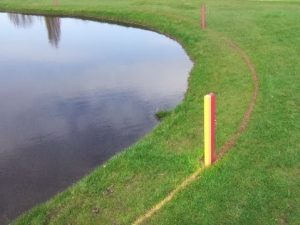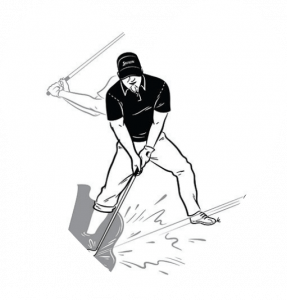A hazard on a golf course is any area which provides a challenging obstacle for the player to negotiate and make his shot. Bunkers, lakes, ponds, and rivers are all common hazards on the golf course.
It can be a knee-knocking experience when facing a water hazard, but the trick is to just focus on the target and not on the hazard.
Nevertheless, every person I know who plays golf has shanked their golf ball into a water hazard at least once in their life. It even happens to the best of players like Tiger Woods, so there is no need to sweat it.
On the other hand, you must be aware of the consequences of hitting the ball in the water hazard. Here is what you should know.
Table of Contents
Penalty For Hitting The Golf Ball In A Water Hazard
Just about everyone who plays golf has hit their ball into a water hazard and needed to take a penalty stroke to get it out.
The rules of golf recognized two different kinds of water hazards. Those defined with the yellow line or yellow stakes commonly referred to as regular water hazards, and those defined with the red line or red stakes called lateral water hazards.

If your ball is in a regular water hazard, you have two choices of how to take it out with the penalty stroke. If your ball is in a lateral water hazard you have four choices.
Regular Water Hazard
When your ball goes in a regular water hazard, for a penalty of one stroke, you can drop a ball behind the hazard anywhere on a straight line drawn from the hole through the spot where your ball crossed over the hazards yellow margin as it went in.
When using this choice, you are allowed to drop as far behind the water hazard as you want.
Your second choice is to play again from where you just played. This is referred to as playing under stroke and distance.
If a player just played from the teeing ground and chooses to play under stroke and distance, he may either place or tee a ball anywhere within the teeing ground.
Lateral Water Hazard
When your ball goes in a lateral water hazard, you have four ways to get it out for penalty of one stroke. Two of the choices are the same ones you have for getting your ball out of a regular water hazard.
1.) You can play under “stroke and distance”
If a player just played from the fairway, he must drop a ball as close as possible to where he made his last stroke but not nearer the hole.
2) You can drop a ball behind the lateral water hazard, anywhere on a straight line drawn from the hole through the spot where your ball crossed over the hazard’s red margin as it went in.
3.) The third choice is the one players most frequently use. You can drop a ball within two club lengths of and not nearer the hole from where your ball crossed over the hazard’s red margin as it went in.
4.) Your fourth choice is to find a spot the same distance from the hole as where your ball crossed over the hazard’s red margin, that is on the opposite side of the hazard and drop a ball within two club lengths of that spot, not nearer the hole.
In addition to the two choices you have to get your ball out of a regular water hazard, and the four choices you have from a lateral water hazard, you are also allowed to play your ball from a water hazard with no penalty stroke as long as you were careful not to ground your club or touch the water with it before you make your stroke.
When your ball is in a water hazard, being aware of all your choices will help you pick the best one available to you. There is no choice that is always the best because water hazards and other factors can vary so greatly.
How To Hit A Golf Ball Out Of Water?

Hitting a golf ball out of water is not an easy feat. Golfers who want to avoid a penalty stroke may try to hit their golf ball out of a water hazard.
The main idea when hitting the golf ball out of water is to get a steep powerful swing. You also want to ensure that at least some part of the ball isn’t fully submerged into the water.
Here are the steps you should take to get the ball out of water without incurring a penalty stroke:
Check The Lie
When checking the lie, you want to ensure that at least half the golf ball is visible above the water line of the pond or lake. Anything less becomes much more difficult for the golfer to hit.
Create Leverage
Players will often put on rain gear when making a shot out of water. This includes outer clothing and footwear thatusually protect the wearer from the rain. Neverthless, when hitting these types of shots, it’s more important to focus on your feet. They should remain stable at all times as stable feet is critical to making the right shot.
You also want to make sure that you have the right balance by widening your stance. The most suitable club to use to get the ball out of water is the sand wedge because they have a wider, more rounded sole. This allows the club to penetrate under the water just like it would slide under the sand in a bunker and bounce back out the other side without getting stuck in it.
If you don’t have a sand wedge, a gap wedge will carry out the job just as good.
Power Up
You want to play your shot as if you are hitting the ball out of a bunker. The concept is the same. Splash what’s under the ball out of the hazard and the golf ball will follow.
You are going to need a steep angle of attack with a powerful hit. Pick up the sand or gap wedge on your backswing and apply a hard-steep downswing that will fly the ball to safety.
That’s all it takes to get your golf ball out of a water hazard without a penalty stroke.
Don’t be like this guy though👇

Is It Safe To Retrieve Golf Ball From Pond?
You should be careful when retrieving a golf ball from a pond or lake as you wouldn’t want to slip in and get wet, even worst drown. You should always contact the golf course manager to find out how deep the water is before you go in. The rules also state that you should be 18 years and older to dive in and retrieve golf balls.
Nevertheless, there are certain tools that you can use to get your golf ball out of the water such as using a golf ball retriever.
They are used by many golfers in order to retrieve lost or misplaced golf balls. Not only are they used in water hazards, but in deep rough and occasional sand traps.
Having a golf ball retriever can also save you some extra cash as it prevents you from losing countless amount of golf balls. The one that I use is the Callaway golf ball retriever that has an ergonomic sure grip that makes it easy to hold on to while fishing your golf ball out of the water hazard. Just click here to check it out



